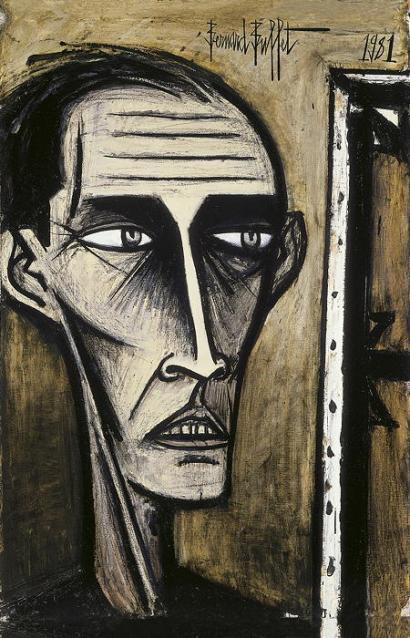|
Bernard Buffet was born in Paris in 1928, in a cultivated middle class family and he spent his childhood in the Batignolles area, in the 17th arrondissement. He started to paint and draw very early on and he passed the entrance examination for the Beaux-Arts School in Paris, when he was fifteen years old. In 1945, the death of his mother Blanche led him to confront aged 17, the anguish of abandonment and was to have a lasting effect. In 1946, he exhibited in the “Salon of the artists under 30 years old”, then in 1947 in the Salon des Indépendants, and in 1948, was awarded at the age of 20, the prestigious Prix de la Critique, which launched his career.
With David and Garnier
As early as 1948, he was under an exclusive contract with Emmanuel David and Maurice Garnier, he remained faithful all of his life to his art dealers who exhibited him from 1956 avenue Matignon, in the Galerie David et Garnier that became Galerie Maurice Garnier, in 1968. In 1955, he obtained the first place in the referendum organized by the magazine Connaissance des Arts, which put him in first position of the ten best post-war painters. After eight years spent alongside him, Pierre Bergé left him for Yves Saint-Laurent and Bernard Buffet fell in love with Annabel Schwob, a singer, actress, and writer whom he married at the end of 1958, and who was to become his muse, and his model for the rest of his life.
After ten years of glory, Bernard Buffet met criticism, loss of love, and the lack of interest of the institutions, but this in no way affected his work, which he lived as a genuine commitment and vocation. The exhibitions and retrospectives continued successfully, as much in France as abroad in prestigious galleries and museums, with the collaboration of his faithful art dealer Maurice Garnier. In 1973, the Musée Bernard Buffet was inaugurated in Japan, in whose garden the painter’s ashes were dispersed. In 1974, he was elected to the Académie des Beaux-Arts, at the age of 46.
The reality of daily life
Bernard Buffet chose, faced with the post-war reign of Abstraction, a figurative painting, realistic whose real subject was man, his feelings, and his tragic fate. He was a member of the group of « l’Homme Témoin ». Seeking truth in his paintings, at a time when the artists were more concerned with political commitment or the debates between figuration and abstraction, he returned, with his subjects, to the reality of daily life, subjected post-war to poverty, destitution, and anguish, with grey and dull colorings and an austere choice of subjects (still-lives, nudes, vanities, crucifixions). He also re-visited the main themes such as death, sexuality, history and painted in the inheritance of the Great Masters, to whom he paid homage on numerous occasions (The Primitives, Rembrandt, Delacroix, Chardin, Courbet, Van Gogh, Soutine ...) by favoring drawing and classic composition.
The tragic painter of the human condition
He was the author of a living painting, nourished with tradition, with beautiful skills – in a perfectly identifiable style whose depth of stroke, the use of a knife and the violence of the tonalities, bring him close to Expressionism – created by a humanistic artist, portraitist of his contemporaries whose joys he expressed as well as their inner sufferings and torments, which were also his own. In the studio’s solitariness, he worked ascetically, with discipline and rigor, close to misanthropy.
For Maurice Druon « Bernard Buffet is the tragic painter of the human condition » (2006). A painter, but also a draughtsman, engraver, designer of theatre, ballet and opera decorations, he created « an art in the service of a life exalted by death in the mirror ». Brigitte Camus. Diminished by Parkinson’s disease, unable to paint any more, Bernard Buffet chose to end his life in October 1999, thus closing a life devoted to painting. « Painting, one does not talk about it, nor analyze it, one feels it. » (Bernard Buffet)
|









